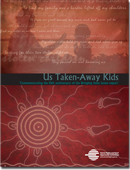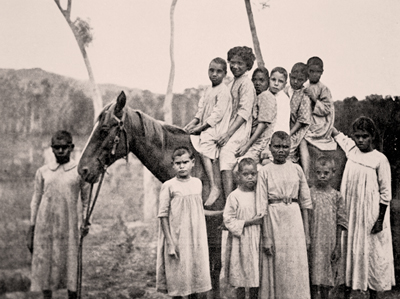Foreword by Tom Calma - Us Taken-Away Kids: commemorating the 10th anniversary of the 'Bringing them home' report
Archived
You are in an archived section of the website. This information may not be current.
This page was first created in December, 2012
Us Taken-Away Kids 
Commemorating the 10th anniversary of the Bringing them home report
Foreword
The contributors to this publication
come from every part of Australia. They are sons and daughters, mothers and
grandmothers, fathers and grandfathers. They are orphans, scholars, single
parents, teachers, prisoners, healers, jillaroos and football stars. Many
continue to suffer the effects of removal, manifesting in drug abuse,
incarceration and mental illness. Thank you for sharing your stories with us,
and shedding more light on what was up until recently, a taboo topic in
Australia’s history. Each of you took a great risk. You looked into the
corners of your hearts that hold your most painful memories and generously
shared them with a national audience. For many of you, it was the first time you
were writing about your experience, or publicly displaying your artwork.
Story telling continues to be crucial to the resilience of Aboriginal
peoples - stories pass on our history, our identity. Storytelling is an
indispensable part of both the recognition of suffering and the journey of
healing.
To commemorate the 10th anniversary of the publication of the
Bringing them home report, it is fitting that we should look to those whose
stories of removal formed the basis of the report and its recommendations. With
this in mind, the Human Rights and Equal Opportunity Commission invited
Indigenous peoples across Australia to tell us their experiences of removal,
their thoughts ten years on from the Inquiry and their hopes for the future. The
poetry, stories and artwork featured in Us Taken-Away Kids are the fruits of
this invitation.
The publication begins with a chronological overview of
the legislation and events which have shaped the lives of Australian Aborigines
since colonisation. This is followed by three themed sections.
‘Mother’ and ‘Journeys and Homecoming’ deal with the
experiences in the life journey of a stolen child. ‘Reconciliation’
includes non- Indigenous as well as Indigenous peoples’ thoughts on moving
forward, to a more inclusive vision for black and white Australia- the voices of
the longest surviving continuous culture in the world, united with those of
their fellow Australians.
For Aboriginal people, the years since the
Bringing them home report have been filled with great hope as well as lost
opportunities. While there have been positive developments and initiatives, many
opportunities for governments to work with our communities and advance the goal
of national reconciliation have been lost.
However, amidst these
disappointments, there are still reasons to hope. The 2006 Tasmanian Stolen
Generations compensation package is a great step forward in the resolution of
the generations of suffering inflicted on Tasmanian Aboriginal people. But the
vast majority of the Stolen Generations are still waiting for this
validation.
Positive steps have also been made in the recognition of
native title. The successful Noongar native title claim earlier this year that
covers much of Perth and the surrounding area demonstrates that two systems of
land title can and should legitimately co-exist.
More recently, the
decision by the Supreme Court of South Australia to award damages to Bruce
Trevorrow in recognition of the harm he suffered through illegal removal from
his family is another step in the right direction. However, Mr Trevorrow’s
victory, like that of the Noongar claimants, only came after years of litigation
because the respective state governments and others opposed their claims. I am
mindful at the time of publication that both decisions may still be appealed.
These victories for social justice are a strong reminder that all
Australians – black and white - must continue to strive for a process of
true and lasting reconciliation. The goal of mutual respect and cultural
understanding will not be borne out of adversarial processes that pit citizens
against their governments. Rather, as a nation, we need to acknowledge the human
rights violations that have occurred and accept that everyone affected by
forcible removals is entitled to reparation and compensation.
Ten years
on, the recommendations of the Bringing them home report still stand as the
starting point for a national reconciliation process. I call on all Australian
governments to implement those recommendations in full, with all possible
urgency, so that all Australians can reach their full potential.
Us
Taken- Away Kids is a testament to the resilience of Aboriginal people, our
ability to overcome adversity, to look to a brighter future, and to triumph in
the face of desolation and despair.
The storytellers within are more
than the faces of Indigenous Australia. These people are the voices of our
living history. Their stories are laden with tragedy, loneliness and loss. But
never far away is their inexplicable optimism. A hope for the future, for our
children, for the Australian nation.

Tom
Calma
Aboriginal and Torres Strait Islander Social Justice
Commissioner
Photograph: Aboriginies at Momamona Mission, 1914. Courtesy State Library of Queensland and Community at Momomona.
Click on image for larger picture.

